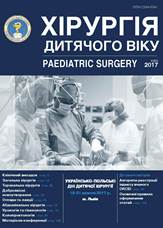Surgical treatment of polyposis in children with peutz-jeghers syndrome
DOI:
https://doi.org/10.15574/PS.2017.57.85Keywords:
Peutz-Jeghers syndrome, polypectomy, childrenAbstract
Objective – to improve methods of surgical treatment of patients with polyposis of the gastrointestinal tract.Material and methods. The study is based on the analysis of treatment outcomes of three children with the Peutz-Jeghers syndrome – two boys aged 12 years and a girl aged 13 years.
Results and discussion. Traditionally, polypectomy due to intestinal polyposis requires multiple incisions of intestine or segmental resection of the affected area, which can lead to various complications. A new method of removing polyps from the intestine without multiple intestinal incisions is proposed. The method provides that, after opening the intestine, a clamp is inserted into it and the gut is crimped on it, while a polyp is detected by palpation. Then the polyp peduncle or the intestine wall near the polyp is clamped, traction is performed, and the corrugated gut is displaced from the clamp, thus causing intussusception before excising the polyp through the incision on the intestine. After the polyp removal, perform disinvagination and repeat the manipulation.
Conclusions. The proposed method of polypectomy can reduce the traumatic nature of surgery and reduce the risk of postoperative complications and is the operation of choice for multiple disseminated polyps of the small and large intestine.
Downloads
Issue
Section
License
The policy of the Journal “PAEDIATRIC SURGERY. UKRAINE” is compatible with the vast majority of funders' of open access and self-archiving policies. The journal provides immediate open access route being convinced that everyone – not only scientists - can benefit from research results, and publishes articles exclusively under open access distribution, with a Creative Commons Attribution-Noncommercial 4.0 international license(СС BY-NC).
Authors transfer the copyright to the Journal “PAEDIATRIC SURGERY.UKRAINE” when the manuscript is accepted for publication. Authors declare that this manuscript has not been published nor is under simultaneous consideration for publication elsewhere. After publication, the articles become freely available on-line to the public.
Readers have the right to use, distribute, and reproduce articles in any medium, provided the articles and the journal are properly cited.
The use of published materials for commercial purposes is strongly prohibited.

